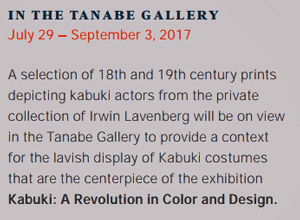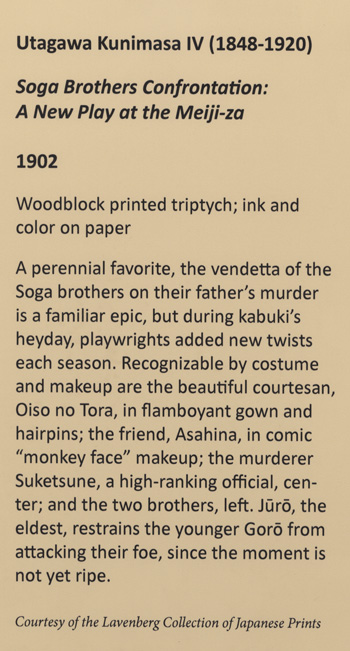About This Print
Five actors, from right to left, Ichikawa Enjō 市川莚女 as Keshōzaka Shōshō 化粧坂少将, Ichikawa Enshō II 市川莚舛升 as Kobayashi Asahina 小林朝比奈 (with kumadori makeup), Ichikawa Sadanji 市川左団次 as Kudō Suketsune 工藤祐経, Sawamura Tosshō III 沢村訥升 as Soga Jūrō 曾我十郎 and Ichikawa Yonezō III 市川米蔵 as Soga Gorō 曾我五郎.In this scene Gorō (on the left in the red robe) challenges Kudō (center) while Jūrō (below and to the right of his brother Gorō) reproves his brother.
Caught in the Act: Woodblock Kabuki Prints from the Lavenberg Collection of Japanese Prints
July 29 - September 3, 2017 in the Tanabe Gallery at the Portland Japanese Garden

dyes that smacked of evolving times. Even so, traditions in kabuki print design remained: details masterfully rendered; cartouches giving the actor's name and role; the action unfolding across multiple sheets of paper.
About the Play
Source: website of the Japan Arts Council http://www2.ntj.jac.go.jp/unesco/kabuki/en/5/5_04_14.htmlThis work is based on the revenge taken by the Soga brothers in the Kamakura period. Its common name is "Soga no taimen" or simply "Taimen" (meeting).
The Soga brothers, Juro and Goro, whose father was killed by Kudo Suketsune, visit Kudo's mansion. Kobayashi Asahina has arranged for the brothers to meet their enemy, Kudo at his New Year's party. Goro receives a sake cup from Kudo, shouts "Enemy who killed my father," and edges close to Kudo to kill him, but his elder brother Juro reproves Goro, saying, "Don't be so impulsive." Kudo implicitly lets the brothers know that he will give them the opportunity to kill him after he has served his term as general administrator for hunting by the Shogun at the foot of Mount Fuji, by throwing the brothers passes allowing them entry to this event instead of giving them New Year's gifts.
The incident in which the Soga brothers killed their father's enemy Kudo Suketsune was circulated to the general public through the story called "Soga monogatari," gaining popular sympathy for them.
In Edo Kabuki, it was customary to perform a work about the Soga brothers in New Year, and the scene in which the Soga brothers meet their enemy Kudo was always included in the program. The roles and makeup, etc. of the dramatis personae in the 'Taimen' scene gradually became stylized, with various Shuko (plot elements) being incorporated as the play was repeatedly performed. The present version of "Kotobuki soga no taimen" is based on the dramatic techniques used when the play was performed in 1885.
All works in which the Soga brothers appear are called Sogamono. They are still regularly performed.
Many of the dramatis personae in this stylized work performed typical roles. Soga Goro is played by an Aragoto actor wearing the type of Kumadori makeup called "Mukimi." In contrast, the elder brother Juro is played by a Wagoto actor with soft carriage of body and speech. Kobayashi Asahina is played as a Dokegata (humorous character) wearing the type of Kumadori makeup called "Saruguma," and he speaks in a comical manner. Kudo Suketsune is played by the Zagashira, the top actor of the company, and Oiso no Tora, Goro's love, is played by the Tateoyama, the top Onnagata.
The Actors Pictured
For background on the actors Ichikawa Enjō, Ichikawa Enshō, Ichikawa Sadanji, Sawamura Tosshō III and Ichikawa Yonezō see their respective entries in the article The Kabuki Actor on this site.Print Details
| IHL Catalog | #847 |
| Title (Description) | Meiji-za Shin Kyōgen - Soga Taimen 梅堂豊斎 曽我対面 (Soga Brothers Confrontation: A New Play at the Meiji-za) |
| Artist | Utagawa Kunimasa IV (1848-1920) |
| Signature | Baidō Hōsai hitsu |
| Seal | no seal |
| Publication Date | 1902 (Meiji 35, 明治三十五年 三 月) |
| Publisher | Tsutsumi Kichibei 堤吉兵衛 located at Tokyo Nihonbashi Yoshikawachō 5-banchi 日本橋区吉川町五番地 [Marks: similar to 26-134; pub. ref. 194] Two columns of characters in the upper left (see below) state that both production and printing were done by the publisher. 作印刷 saku insatsu (production and printing) 兼発行者 ken hakkōsha (both done by publisher) |
| Carver | not given |
| Impression | excellent |
| Colors | fair - printing variation in background of right panel |
| Condition | good- margins trimmed; minor soiling; minor ink offsetting in right panel; not backed |
| Genre | ukiyo-e; yakusha-e |
| Miscellaneous | |
| Format | vertical oban triptych |
| H x W Paper | 14 x 9 3/8 in. (35.6 x 23.8 cm) each sheet |
| Literature | |
| Collections This Print | Japan Arts Council 04128 |





